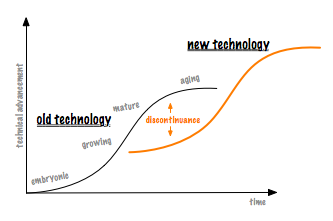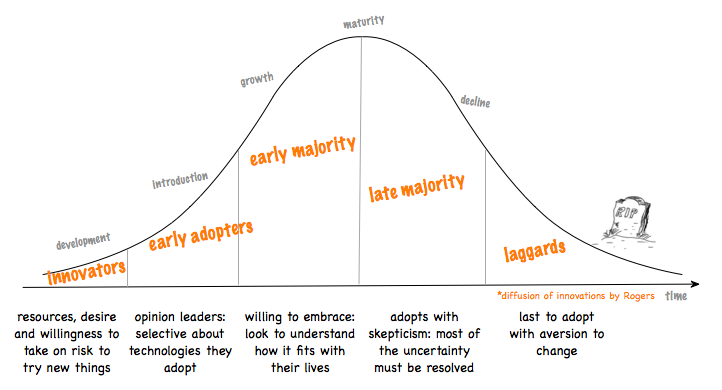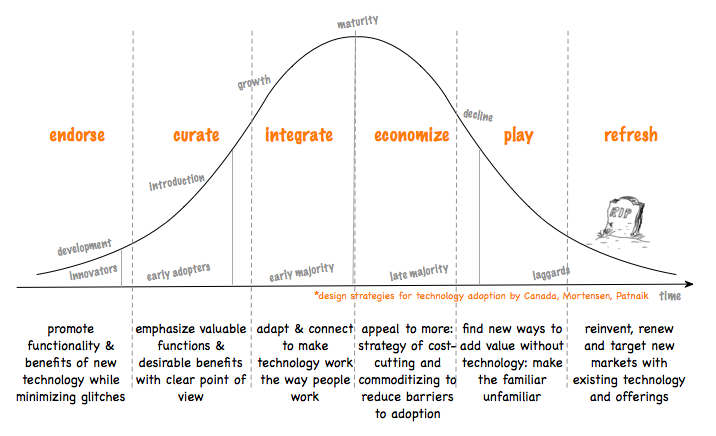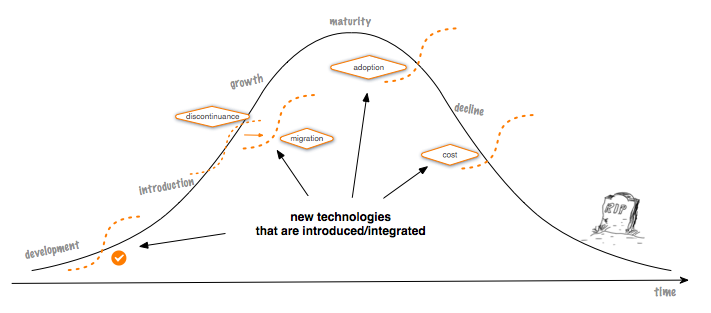Recognize Technology Expectation Gaps
Managing expectations is part of the successful product execution process, and this article focuses on how to spot technology expectation gaps utilizing concepts from technology maturity, life cycle and diffusion of technologies.
[Originally from the Kitetail Blog]
Statistically, the successful launch of new products are rare, as there are many challenges to overcome. The successful development of new products incorporating new technologies is even more challenging. Execution matters for success, and is all the more critical for technology focused products. Managing expectations is part of the successful execution process, and this article focuses on how to spot technology expectation gaps.
“Oft expectation fails, and most oft where most it promises; and oft it hits where hope is coldest; and despair most sits.”
— Shakespeare
So, what is a technology expectation gap?! Whenever there is a disparity between the value or experience delivered (feature, performance, quality, …) by technology vs. what customers and users actually perceive they are getting, we have an expectation gap!
For high-technology products, the existence of an expectation gap is a given; it is the nature of the beast. New technologies are constantly chasing the old ones, but never quite catching up. If successful, they enable breakthrough innovations, new product categories, markets and users. But until they are successful, there are lot of judgements, hopes, dreams and disappointments that are laid upon them. However, by utilizing concepts from technology maturity, life cycle and diffusion of technologies, one can recognize potential expectation gaps (internal and external) and manage them for success, or exploit them as a competitive advantage.
Technology Maturity
 Technology Maturity
Technology Maturity
The technology maturity process feels a lot like watching kids grow up… From a baby to a child, teen and finally an adult. Understanding this process can give the needed insights and observations for better management of business, technology and expectations. For instance:
- What is crucial and sensible for one stage, may not be appropriate for the next. In the embryonic stage, aggressively developing key functionality is critical to showcase the potential for the new technology. But, as the technology grows and matures, performance and cost become the driving factor.
- Technology maturity is a good risk indicator for increased vulnerabilities, as it will experience emergence of substitutes.
- Recognizing the maturity level of a technology can feed into business strategy and portfolio management process. Such as, relocating resources away from mature and aging technologies.
When a new technology enters the scene, its performance and functionality will not match the existing technology capabilities. This is expected, as one to one substitution is rarely an incentive for the new technology creators. However, as we integrate/introduce this new technology with our product, customers and partners may not share our same excitement about this new technology. And frankly, internal partners and program team (Customer Support, Marketing, Sales, …), maybe our loudest critics. To better understand the conflict, lets take a look at the product life cycle and technology adoption framework.
Design for the Technology Adoption
 Innovation diffusion
Innovation diffusion
 Innovation adoption design strategies
Innovation adoption design strategies
Understanding technology diffusion and designing for technology adoption is crucial for new product success. In summary:
- Technology and innovation is a change: change in the behavior of customers, in how they work and produce. It is important to recognize the change, design and manage it accordingly.
- We need to understand the needs, values and characteristics of our customers in the context of where our technology and product is positioned, as well as where our customers believe it is positioned at. Through this understanding, we can focus at delivering value to increase adoption rates.
- It is important not to fall in love with our technology and ideas, but to continuously analyze and question your assumptions.
If we have a one-to-one-to-one match between where our technology, product and customers are at, life is wonderful! We aligned all the dots. However, technology has a life of its own, and every product incorporates one or more technologies… So…
WHAT A BEAUTIFUL LIFE… THE LIFE OF TECHNOLOGY…
 Potential expectation gaps
Potential expectation gaps
Technology expectation gap occurs when your technology maturity, product life cycle and customer stages conflict. The result could be a simple irritation and loss of customers, to more extreme public outcry such as Google Buzz experienced when it was released without appropriate privacy controls (and later their public apology. I guess they weren’t paying much attention to all the racket over at Facebook…)
These gaps can be experienced in the various dimensions, such as cost, performance, scalability, flexibility, functionality, usability, deployability and maintainability. And, they may have differing impacts to your internal and external customers/partners. Once you internalized the tension and are aware of the gap, you can use communication tools, ecosystem partners and positioning strategies to mitigate impact.
Mismatch of technology/product with customer segment
Positioning your new technology for adoption by a maturing customer segment will certainly raise eyebrows. Recently, Google announced the WebP image format for the Web. WebP’s adoption as a substitute will be interesting to watch, as existing image solutions have been around for a long time. With that, key areas that need to be managed are:
- penetration to the existing ecosystem in order to speed the adoption process: browsers, content creators, image converters, content management systems, … Building ecosystem maps, identifying key partners, control and influence points will certainly help the process.
- development and evolution of WebP functionality to address existing concerns and achieve the good enough stage. Communicating planned roadmaps with time frames, and being clear with users on WebP best practices (rather than positioning it for mass market) can help position it appropriately with skeptics.
Migrate to a substitute technology, or upgrade your existing technology
Whether you migrate to a substitute technology, or even just upgrade your existing technology, you will experience some level of discontent. This could be experienced as deployment and maintainability woes by your support team, or performance, flexibility and functionality conflicts for your customers.
Understanding your customers’ use models, as well as extreme use cases will shape your migration and upgrade strategy. When appropriate, call on your ecosystem for support, such in the case with iOS and H.264 vs. Flash. Utilizing HTML5 and transcoding, Apple’s ecosystem has been increasingly delivering H.264 video to iPhones/iPads. In summary, instead of working to increase the capabilities of substitute technology in all dimensions, think outside the box to see how else you can reduce gaps in acceptance.
Announce the discontinuance of your technology or product functionality
For product managers, managing discontinuance is a challenging area. Perhaps more so due to emotional attachment than factual reasoning. Either way, when your customers are arguing against your discontinuance plans, you better listen.
When appropriate, offering the new technology along with the existing one can allow your customers to migrate themselves, such was the case with transition from floppy drives to CDs and beyond. Another strategy that could work is using ecosystem partners to fill-in gaps as needed. However, as in the case with Netflix, if you have no workable solutions, be ready to retract on your announcements.
Implement a technology as its standard is being defined
There’s nothing like building the airplane wings while the plane is lifting off the tarmac! Implementing a new standard as the standard itself is being defined will certainly appeal to your visionaries and early adopters. Clearly communicating the capabilities of the new technology, such as the HTML5 showcases, will feed excitement and accelerate adoption. However, positioning and maintaining clear communication is a must, as technology implementation or its interpretation will change, potentially resulting in frustrated customers.
Change your technology strategy at midcourse
OK! This is given; technology directions can and will change on a dime. However, people don’t like change and uncertainty, especially when it is delivered in the form of an unwelcome surprise. This highlights the importance of maintaining communication with your customers, and utilizing your close relations with your supporters when change is coming. Through this, you can prepare your customers, but also build a compelling story that they can rally behind to support you in the shift.
Increase customers’ intangible costs
Any changes to your technology and technology strategy will somehow impact your customers’ bottom line. This could be due to unexpected system upgrades, time and cost associated with learning the new technology, or just changes in the usability of your system. Key point here is do not to underestimate the impact of your changes, and help your customers to transition successfully. Alpha/beta testing can help identify unanticipated impacts, and highlight strategies to address existing gaps prior to your release.
PARTING THOUGHTS…
“There is nothing more difficult to plan, more doubtful of success, nor more dangerous to manage than the creation of a new system” – Niccolo Machiavelli, The Prince
A bit of understanding and utilizing frameworks can help to spot gaps. Through this, and technology and product roadmap alignment, you could do a better job of communicating and managing these gaps. These frameworks can also help you identify gaps in your competitors’ offerings and enable you to build a more competitive offering.